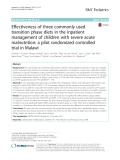
Osmotic diarrhea
-
The case fatality rate of severely malnourished children during inpatient treatment is high and mortality is often associated with diarrhea. As intestinal carbohydrate absorption is impaired in severe acute malnutrition (SAM), differences in dietary formulations during nutritional rehabilitation could lead to the development of osmotic diarrhea and subsequently hypovolemia and death.
 8p
8p  videshiki2711
videshiki2711
 19-02-2020
19-02-2020
 15
15
 0
0
 Download
Download
-
Table 46-3 Causes of Hypokalemia I. Decreased intake A. Starvation B. Clay ingestion II. Redistribution into cells A. Acid-base 1. Metabolic alkalosis B. Hormonal 1. Insulin 2. β2-Adrenergic agonists (endogenous or exogenous) 3. α-Adrenergic antagonists C. Anabolic state 1. Vitamin B12 or folic acid (red blood cell production) 2. Granulocyte-macrophage colony stimulating factor (white blood cell production) 3. Total parenteral nutrition D. Other 1. Pseudohypokalemia 2. Hypothermia 3. Hypokalemic periodic paralysis 4. Barium toxicity III. Increased loss A.
 5p
5p  ongxaemnumber1
ongxaemnumber1
 29-11-2010
29-11-2010
 106
106
 5
5
 Download
Download
-
The source of free water loss is either renal or extrarenal. Nonrenal loss of water may be due to evaporation from the skin and respiratory tract (insensible losses) or loss from the gastrointestinal tract. Insensible losses are increased with fever, exercise, heat exposure, and severe burns and in mechanically ventilated patients. Furthermore, the Na+ concentration of sweat decreases with profuse perspiration, thereby increasing solute-free water loss. Diarrhea is the most common gastrointestinal cause of hypernatremia.
 5p
5p  ongxaemnumber1
ongxaemnumber1
 29-11-2010
29-11-2010
 98
98
 7
7
 Download
Download
-
Hypovolemia Etiology True volume depletion, or hypovolemia, generally refers to a state of combined salt and water loss exceeding intake, leading to ECF volume contraction. The loss of Na+ may be renal or extrarenal (Table 46-1). Table 46-1 Causes of Hypovolemia I. ECF volume contracted A. Extrarenal Na+ loss 1. Gastrointestinal (vomiting, nasogastric suction, drainage, fistula, diarrhea) 2. Skin/respiratory (insensible losses, sweat, burns) 3. Hemorrhage B. Renal Na+ and water loss 1. Diuretics 2. Osmotic diuresis 3. Hypoaldosteronism 4. Salt-wasting nephropathies C.
 5p
5p  ongxaemnumber1
ongxaemnumber1
 29-11-2010
29-11-2010
 61
61
 4
4
 Download
Download
-
Constipation: Treatment After the cause of constipation is characterized, a treatment decision can be made. Slow-transit constipation requires aggressive medical or surgical treatment; anismus or pelvic floor dysfunction usually responds to biofeedback management (Fig. 40-4). However, only ~60% of patients with severe constipation are found to have such a physiologic disorder (half with colonic transit delay and half with evacuation disorder).
 6p
6p  ongxaemnumber1
ongxaemnumber1
 29-11-2010
29-11-2010
 75
75
 3
3
 Download
Download
-
OSMOTIC CAUSES Osmotic diarrhea occurs when ingested, poorly absorbable, osmotically active solutes draw enough fluid into the lumen to exceed the reabsorptive capacity of the colon. Fecal water output increases in proportion to such a solute load. Osmotic diarrhea characteristically ceases with fasting or with discontinuation of the causative agent.
 5p
5p  ongxaemnumber1
ongxaemnumber1
 29-11-2010
29-11-2010
 60
60
 2
2
 Download
Download
-
SECRETORY CAUSES Secretory diarrheas are due to derangements in fluid and electrolyte transport across the enterocolonic mucosa. They are characterized clinically by watery, large-volume fecal outputs that are typically painless and persist with fasting. Because there is no malabsorbed solute, stool osmolality is accounted for by normal endogenous electrolytes with no fecal osmotic gap. Medications Side effects from regular ingestion of drugs and toxins are the most common secretory causes of chronic diarrhea.
 5p
5p  ongxaemnumber1
ongxaemnumber1
 29-11-2010
29-11-2010
 65
65
 3
3
 Download
Download
CHỦ ĐỀ BẠN MUỐN TÌM



















